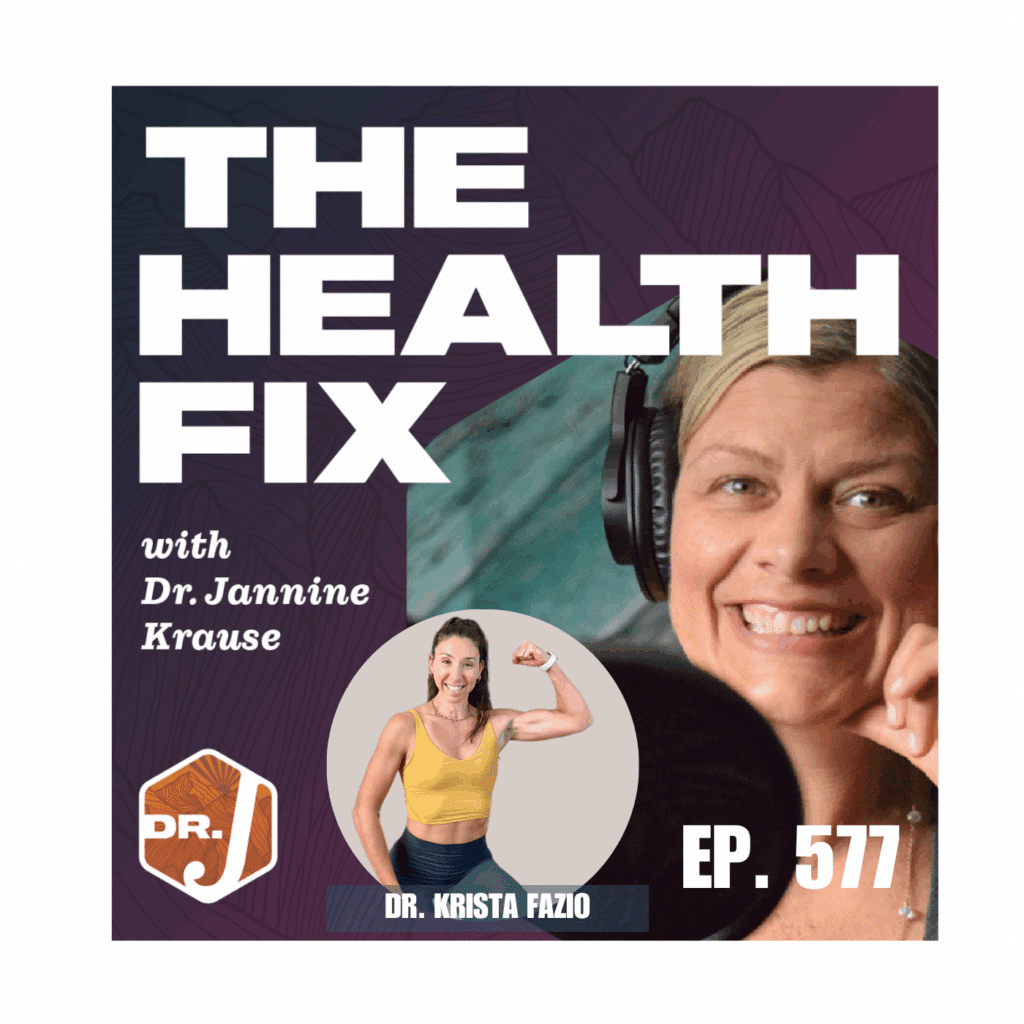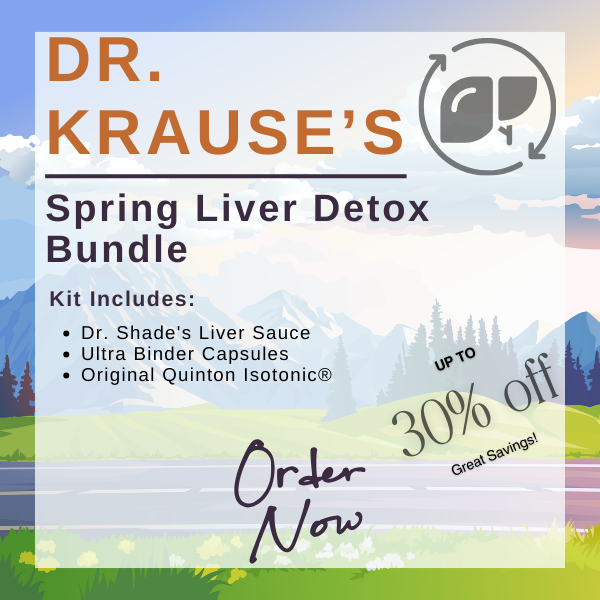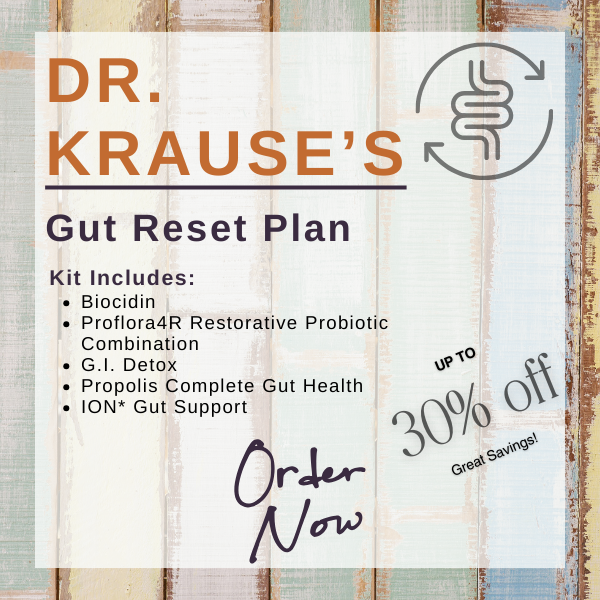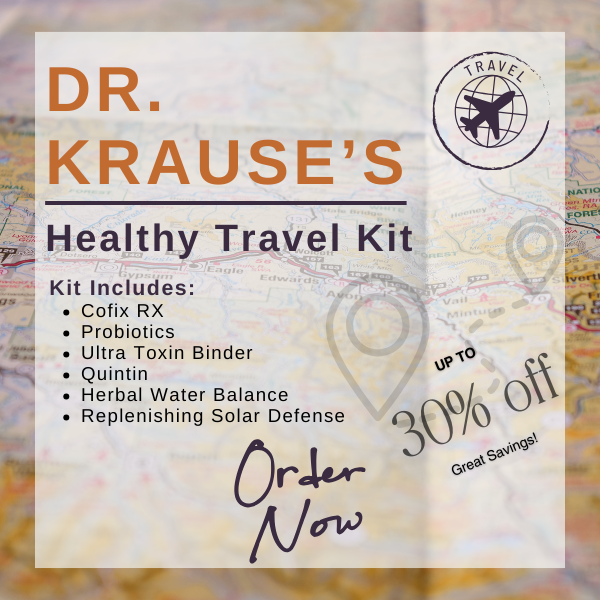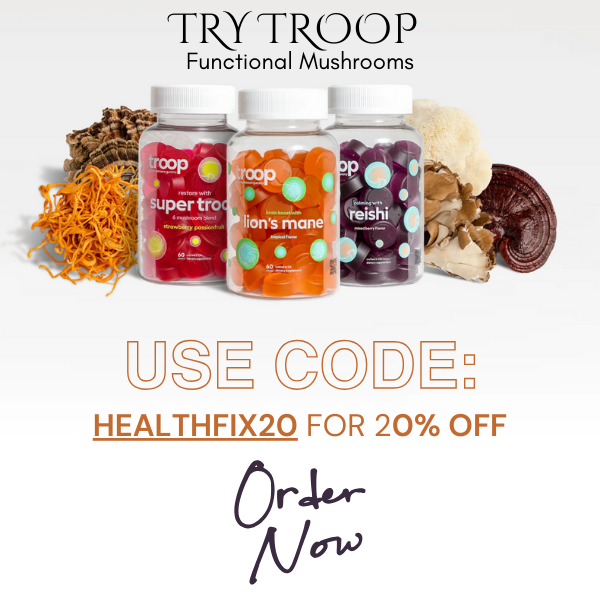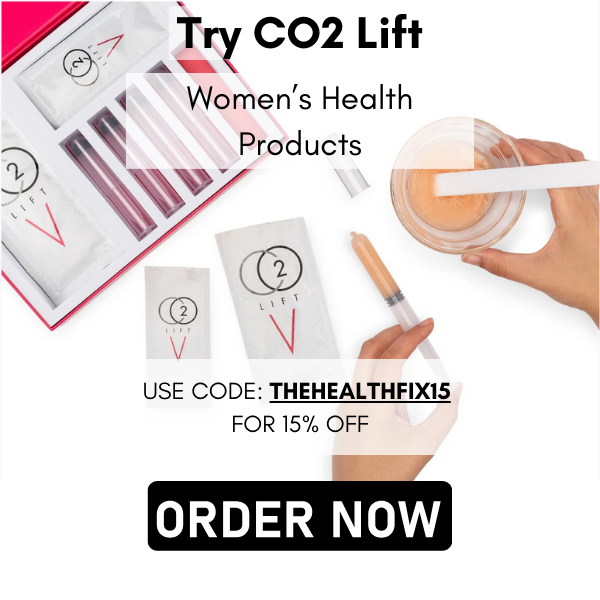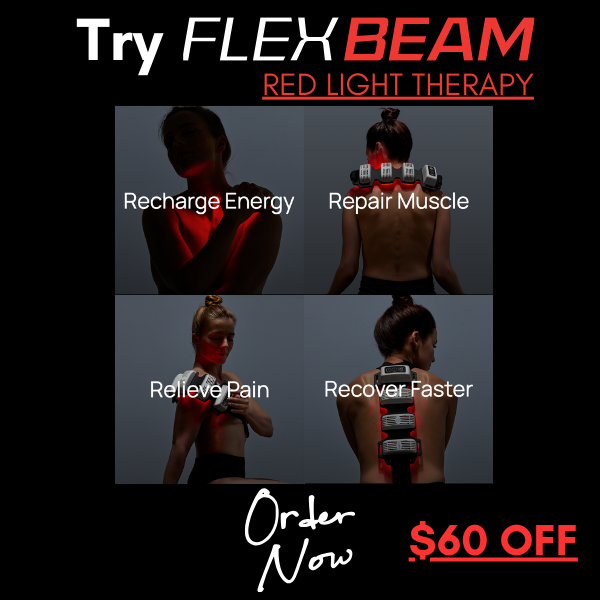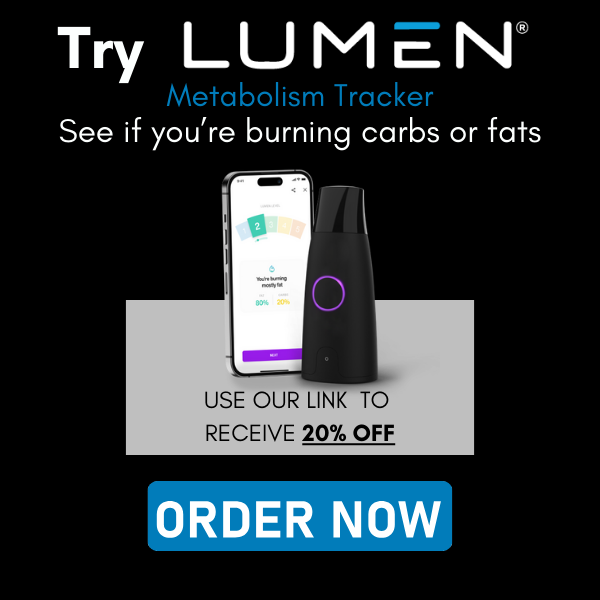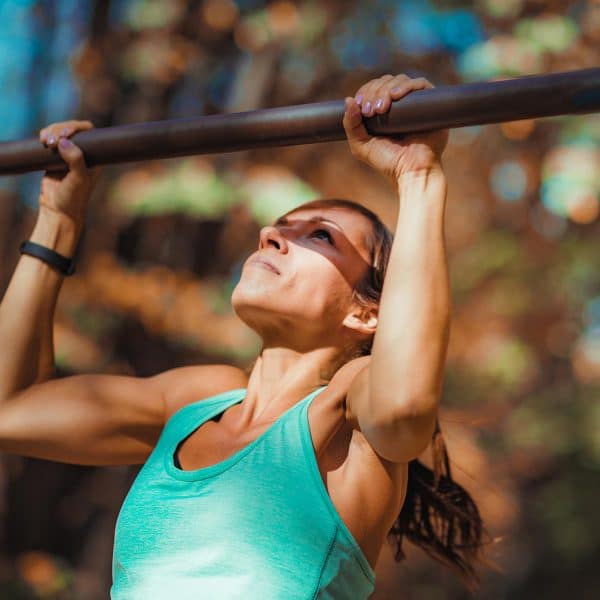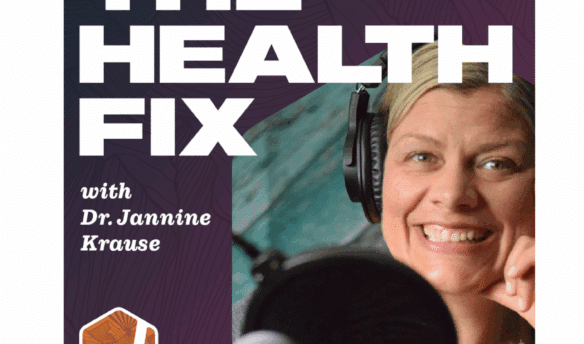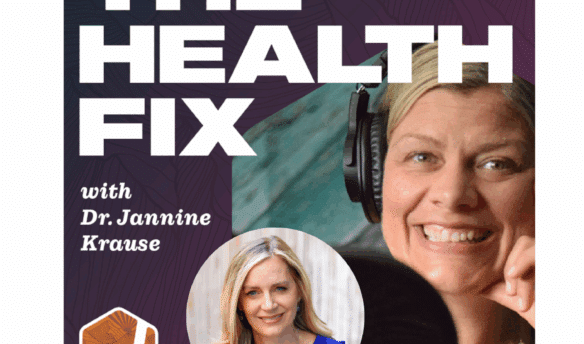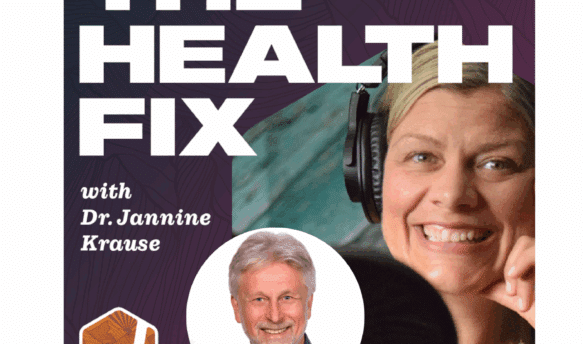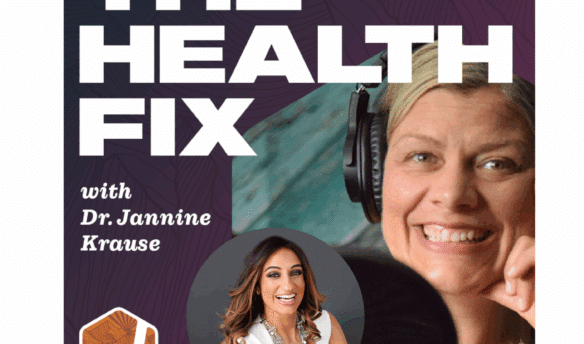On this episode of The Health Fix Podcast, Dr. Jannine Krause interviews, Dr. Krista Fazio on the benefits of seeing a physical therapist to optimize your movement as you get older. Dr. Krista is an experienced Physical Therapist and Licensed Athletic Trainer with a diverse background in treating everyone from elite athletes to post-op patients. She integrates rehabilitation principles with customized workout programs to help people move pain-free, regain strength, and prevent injury. Her Instagram is loaded with incredibly helpful tips to help you move better and kick pain to the curb.
Her approach goes beyond rehab as she blends movement with nutrition support, offering healthy recipes, meal prep ideas, and cookbooks to support optimal health. She’s teamed up with her nutritionist husband, Adam Ross to offer comprehensive online access to personalized physical therapy and nutrition all in one setting.
Dr. Krause’s Protocols
Instructions Included
Traveling soon? Looking to detox or reset your gut? Try one of Dr. Krause’s Fullscript plans.
What You’ll Learn In This Episode:
- How online physical therapy allows for personalized, accessible care without the limitations of insurance.
- What Dr. Krista is doing to help clients tackle the most common issues women experience like back pain, shoulder pain, and pelvic floor dysfunction.
- Why functional movement = longevity: maintaining strength, mobility, and independence is crucial as we age.
- The most overlooked motion that’s essential for healthy movement patterns.
- How to improve pelvic floor health with simple at-home exercises.
- Why hip internal rotation is vital for mobility and injury prevention.
- How Dr. Krista integrates rehab exercises into fitness routines
- The importance of foot health as the foundation for proper body mechanics and movement.
Resources From The Show:
- 1:1 Online Evaluations (via video call) → identify compensation patterns & build a custom workout plan.
- Personalized Rehab & Fitness Programs → move pain-free, gain strength, and restore function.
- Stay Tuned for Dr. Krista’s Workout & Nutrition App for ongoing support.
- Connect with Dr. Krista:
🔗 Website: https://www.arnutrition.net/about
📸 Instagram: https://www.instagram.com/dr.kfazio/
Our Partners
Podcast Transcript
Chapters
00:00 Introduction to Online Physical Therapy
02:33 The Benefits of Online Physical Therapy
04:24 Common Issues in Women Aged 35-65
09:15 Functional Movements for Independence
12:36 The Importance of Rotation in Movement
16:06 Pelvic Floor and Core Health
17:56 Internal Rotation Exercises
20:38 Addressing Tech Neck and Posture
23:28 Progressing Beyond Basic PT Exercises
26:15 Assessing Mobility and Identifying Issues
27:50 The Importance of Glute Activation
30:33 Understanding Foot Mechanics and Pain
33:31 The Kinetic Chain: Why Everything is Connected
35:54 Comprehensive Body Assessments in Physical Therapy
38:56 Integrating Rehab and Strength Training
43:17 The Importance of Consistent Strength Training
49:36 Introducing the New App for Holistic Health
Jannine Krause (00:01.759)
Krista, Faizia, welcome to the Health Fix Podcast.
Krista Fazio (00:05.038)
Thank you, thanks for having me.
Jannine Krause (00:06.911)
Well, I’ve been wanting to have you on since of course, Adam, your husband talked you up and folks who are listening, this is Adam from AR Nutrition. We’ve had him on the podcast a couple of times. He speaks the truth about nutrition. And so I’m like, you know what? Let’s bring Krista on and talk about her side of things in physical therapy and all the things physical therapy that you’re helping folks with online. So I’m really excited to talk today. One of my…
big things that I have chatted with folks about over and over again is one, just like we were talking about before I hit record, it’s becoming harder and harder to get into physical therapy. And two, sometimes it’s really nice to do physical therapy exercises at home because now we can learn what to do. You can use your equipment at home and all those things. So tell us a little bit about how long have you been online doing PT and what kind of things do you love about doing online physical therapy?
Krista Fazio (01:00.128)
Yeah, so I worked in a outpatient clinic for like eight years or so. It was a long time. And then I finally like made the switch over to online. And honestly, I wasn’t sure about like, I was like, I don’t know if people are going to like, really do this. Like, it’s kind of seems like it’s something that everyone’s going to want in person. Like, I don’t know if this is if we make this work, like, we’ll kind of like see what happens.
Jannine Krause (01:14.911)
Thank
Krista Fazio (01:25.376)
And to my surprise, it’s been awesome. It’s really great being able to connect with people all over the world.
people who are like limited and they can’t find like good help or quality care. Just like being online just makes things so much easier. having like being able to build people out these custom programs that don’t have to be held by what the insurance company wants you to do and how we have to bill and all these crazy limitations that you get in the clinic. I mean, I used to treat like up to like six patients in one hour. So like, how are you giving people really like the attention and care that they need and deserve when you
have six other people that you’re trying to get to. It’s insane. honestly, I found that moving online has been able to actually give people better care, which sounds crazy, but I’m actually able to like focus in on what they actually need and build them out these custom programs and we can tweak it and adjust it. And, you know, we’re not on this like time constraint and, you know, handcuffed with the insurance company. So I’ve honestly, I love it. It’s, it’s really been great and I will probably never go back.
Never say never, but I don’t see myself going back.
Jannine Krause (02:36.895)
don’t blame you, I don’t blame you. I having left the insurance world, it’s so freeing because as you know, I mean, how can anyone learn anything from a physical therapist when it is like six patients in an hour? Most of the time I hear like in the common models, it’s like handoff to OT, know, or not OT, but physical therapy assistant. And then, you know, no disrespect to some of the PTAs, some of them are awesome. It’s more just, that’s how it goes.
And a lot of times folks call me, getting, you know, they’ll go through their exercises and they sit with ice for like a half hour, like something ridiculous on the back end.
Krista Fazio (03:13.036)
Yeah, yeah, the heat and stim for like 20 minutes and then like the classic three exercises and like a little rub down and ice and you’re out the door is like kind of the classic treatment that, which is why I was just like, I can’t do this.
Jannine Krause (03:29.383)
Yeah, no, it’s definitely something that, you I’ve always looked at that model and been like, no, that doesn’t work. And not only that, I think a lot of women are really struggling with joints that’ll get frozen, like especially the shoulders as we get older and the intricate like muscles we need. Like, I don’t know if you’ve seen this, but so many women will reach to the back of their car to grab their purse and then they’re like, I can’t move my arm anymore.
Krista Fazio (03:44.333)
us.
Krista Fazio (03:56.727)
Yes.
Jannine Krause (03:57.023)
It was like this should not be happening, right? Like this, we should be stronger than this. I think. So tell me a little bit about, you know, what are the most common things you see from women 35 to let’s go to 65? Like what kind of things often happen to us and what kind of things can we be looking at and go, could I benefit from PT here? Because a lot of people are gonna be like, I’m just stuck with this pain or I’m just stuck with this limited mobility. Let’s open up their minds a little bit here.
Krista Fazio (04:27.148)
Yeah, I don’t like, I think people kind of see it as like, okay, I’m getting older, I should expect to have these aches and pains, and I’m going to get more limited because I’m older. And that’s just not the way we should be thinking about it. If we keep ourselves moving, and we are following like a proper program that has the mobility and the muscle activation and the strengthening that we need, there’s no reason why you can’t maintain that stuff as you get older. And even if
you have let yourself go for a few years and you’re getting all these aches and pains and you’re not moving well, there’s no reason why you can’t get them back. It’s not like you are too old. I hear people say, I’m too old to be able to do that. You’re not. You’re really not. You can take someone who’s like 90 years old and start helping them with a squat or something and you will see improvements. You’re not limited by your age. I think that’s more of this mental societal thing that we’ve kind of just put in.
our heads that like, okay, we’re getting older, time to kind of scale it back and like, I don’t want to hurt myself and I can’t move like that anymore. Like, I think that’s really something that like we just as a society just need to like get over and like leave in the past. But some common things that I typically see, I mean, back pain, of course, is like rampant, like everybody has back pain.
And I think that people get very freaked out by their diagnoses. People will go get MRIs and they’ll see degenerative disc disease and disc bulges and maybe a couple herniations and they think, okay, I’m broken. I have all this stuff going on. This is crazy. They get all freaked out. They get all stressed out. And the truth is that
our bodies are going to degenerate over time. It’s just the way it is. It’s totally normal to have a spine that’s degenerating. Like that’s literally normal. If you look at anybody over the age of 35, we’re all going to have these little degenerations going on and some bulges and some different things going on. And not to say that you should overlook those things, especially if you’re getting like severe pain and stuff. But I just think that putting the label on it, it just does more harm than good.
Krista Fazio (06:44.496)
can bring yourself back from that. It doesn’t mean that because you have these certain diagnoses that you’re always going to be in pain or you’re always going to be limited. That’s not the case. Like, you can have all these things and literally have no pain and full motion. But if you go out to the MRI, you’ll still have the degeneration and some disc bulges. And that’s kind of normal. But I think we just kind of freak ourselves out. And like, I think a lot of doctors kind of like just strut like, you know, they just make you nervous about all these different things going on when
Really, you can work yourself out of the pain and you can totally make a full comeback from those things. Another thing that’s super common is just the postural changes over time. We’re all just so hunched over on our computers and yeah, our shoulders are super tight, our chest is tight, our back gets weak, our chin comes forward. You get that little hump in your back.
That’s another thing I see a lot and it really affects the shoulders, especially on women. Their shoulder blades aren’t gliding properly when you raise your arm up over your head. So that’s another big thing that we work on a lot is stabilizing that shoulder blade and opening up your chest and just restoring the posture and strengthening up the muscles in the back and getting your chin back and everything. So those are probably the two biggest things is back pain and shoulder issues, I would say.
Jannine Krause (08:10.47)
100%. I would agree. I would agree just knowing myself even and looking at, you know, imaging, think that’s a great point you made about the degenerative, you know, disc degenerative or, you know, this and that. A lot of people come to me and be like, I’m falling apart. I’m like, I wish that terminology just wasn’t there. You know, for what I wish it was just like, okay, we got some signs of agey. No big deal. why we getting older? Ay, yi, yi. So.
Krista Fazio (08:30.211)
Yeah.
Krista Fazio (08:34.978)
Yeah. Yeah. Yeah, for sure. And I hate when people are like, I’m broken. I’m like, no, you’re not broken. You’re just, you’re aging. Like we’re all aging. It’s okay. It’s totally normal. Like we just got to get you out of like that pain cycle. Like it doesn’t mean that you’re going to be like this forever.
Jannine Krause (08:52.859)
Absolutely, absolutely. Well, the pain cycle is a big thing. And this is something I would love to talk about because I think for a lot of women, what’ll sometimes happen is they’ll notice like all of a sudden they’re not able to get, you know, on the floor and get back up, right? Like all of a sudden they’ve lost that. Or like I always describe it and this is why I love doing squats and my kind of joke is like, if you’re gonna go to a public restroom, you need to have your quads and your glutes because you do not wanna be sitting on something.
Krista Fazio (09:18.67)
100%.
Jannine Krause (09:22.621)
You guys are in New York, you know what that’s like. So it’s a matter of like, okay, how do we help folks understand what is key here to maintain over a lifetime? What’s important? So when you assess someone’s posture, assess someone’s strength, where do women need to be thinking about, or maybe what kind of things, like from getting from the floor up, what kind of metrics do you have people look at to be like,
Ooh, I might need some PT here.
Krista Fazio (09:55.063)
Yeah, 100%. And I think it’s based on more like functionally, like what are the things we need to be able to do as we get older? And right now, like everyone’s doing the same movements, right? On repeat. And you might notice that over time you’re like, that’s getting kind of hard. Like I can’t, I can’t do that anymore, whatever it is. But I mean, definitely like everyone needs to be able to do a squat. That’s like, have you ever like tied, went bent down to tie your shoe or like pick something up or pick up a package or
even like pick a kid off the floor or anything like that, like a squat is like absolutely like necessary, reaching overhead, like putting the dishes away or like putting anything overhead or doing your hair, like those things are just like, you have to do them, like it’s kind of hard to not be able to do that.
So yeah, so definitely like a lot of shoulder mobility, hip mobility is huge as well. Like you said, like getting up off the floor, like God forbid you fall or, you know, you’re on the floor playing with your kids or whatever it is, you need to be able to get up. And sometimes you won’t have someone there to help you up or you might not have something to grab onto to pull yourself up. And you’re relying on your muscles and your strength to get up and be able to do these things without, you know, it’s scary like to be like on the floor and not, you know, not be confident that you
get yourself up. Like no one wants to be trapped in like that situation. So just staying, you know, mobile and functional in the ways and the things that you need to do. I even have people who, like older people who like they love to travel. But guess what? Your luggage is like 50 pounds. Like you need to be able to carry that luggage around and bring it up the stairs and put it on the overhead bin when you travel. And like all that stuff takes mobility and strength. So a good combination of the two is definitely like
for just being able to live out like a healthy happy life and do the things that you want to do not be limited by your own body.
Jannine Krause (11:56.671)
Absolutely, absolutely. Well, one of the things I think is really important for myself, but I think for a lot of women, is what can we maintain, just like you’ve described to do at our adventures, but also to stay out of nursing homes, to stay out of assisted living for as long as possible, or maintain your independence for as long as thinking possible. And so it sounds like squats, overhead motion, those kind of things. And in terms of-
Krista Fazio (12:24.972)
Yeah, and another thing that’s always… Another movement that I find is very, very overlooked, like very overlooked. In most training programs, I see almost…
Jannine Krause (12:27.655)
No, no, go ahead.
Krista Fazio (12:39.924)
all clients who come to me, like they’ve never trained this before, is rotation. And I don’t know why people have gotten afraid to rotate or when we got this thing in our head that, you know, rotating your spine is like bad for it or rotating your hips. Like we rotate every single day. We rotate with every step we take. As we walk, we literally rotate our body. We rotate our spine. So I don’t know where we got this thing where like rotation…
isn’t bad or we should just like overlook it and only train in like straight planes but like we’re not robots like we do not function in like in like straight
like planes of motion. Like we are, we’re all over the place. Like we’re dynamic. rotation I think is so overlooked in training programs. I don’t know why most, most people and trainers and stuff, like they don’t program that stuff in, but like hip rotation is like vital. Like you can’t even get into a deep squat if you don’t have the proper hip internal rotation. You’re, you’re rotating your spine literally every single day. So why not train it so that we’re stronger in that movement so that when we do have to do that, we don’t throw our backs out and you know, injure ourselves.
Like let’s build up some resilience in those motions instead of just training like literal like robots, which is not the way we function at all.
Jannine Krause (13:57.759)
It’s so true. And you’re right. I’m lucky enough to have a trainer who definitely does do that. I’ve seen, I mean, if you look at the old weight lifters, right? They’re all carrying buckets and not really rotating much. mean, I am rotating slightly, but it’s very stiff. what kind of, someone who’s listening might be thinking like, what kind of am I doing that right now? And especially with the hips, because the hips in the back and the pelvis for women is such an area.
Krista Fazio (14:07.746)
Yes.
Krista Fazio (14:14.529)
Yes.
Krista Fazio (14:24.322)
huge.
Jannine Krause (14:25.535)
What kind of movements would people be thinking about? Like, can you do it? Should you do it? You know, those kind of things.
Krista Fazio (14:31.574)
Yeah, I mean, I would say like hip internal rotation is probably one of the most important movements to train and become mobile in. And that’s like you said, like that’s going to loosen up your low back. It even like affects like your knees. Like it literally affects like a lot of different like deficits that people have going on when they have knee pain or back pain. It’s literally because their hips, they they’re stuck, like they don’t rotate. So then your back kicks in to compensate and then your knees get this like funky mechanics going on. So
So hip internal rotation for sure is one of those things that I make every single one of my clients do some sort of hip internal rotation exercise. I just think it helps with so many compensations. And yes, women especially, they’ll have troubles rotating their pelvises, doing posterior pelvic tilt and different deep core exercises that has to go with your breathing and your core mechanics and target
the deep core all together as one unit. And that’s something that people really struggle with, especially after they have babies, because that whole dynamic is just like really thrown off and your core gets very weak and your pelvis is like, you know, everything’s just kind of like out of whack there. So I see that a lot in women who who recently had babies or or have just been struggling with like hip pain. But it’s really like your pelvis and your breathing and your diaphragm and your deep core. Everything is just not kind of working properly together.
So like re-establishing like those connections for women is like huge, especially after having a baby.
Jannine Krause (16:09.359)
Man, I think that’s probably where we went wrong here at least in the states for so many women Like now who are in their 50s 60s and beyond Because there was no real pelvic floor physical therapy trend now. It’s now it’s all over the place But I feel like we could you know, and and this is something I’m gonna you know Obviously defer to you about it seems that a lot of the physical therapists who are in the pelvic floor department are Overwhelmed like they’re busy as heck. So
Correct me if I’m wrong, but like you just said you’re doing some pelvic floor like I Just said pelvic floor tilts pelvic tilts and and internal rotation work and in different work there You could be working on the pelvis without in the pelvic floor without having to get internal or any of that correct
Krista Fazio (16:58.51)
100 % and I think people think that like pelvic floor like specific pelvic floor PT Like you have to do like one-on-one with someone in like a clinic and it has to be like this whole thing I also know that a lot of it’s not even covered for some reason for a lot of women like I’ve had a lot of women come to me and be like It’s a crazy amount of money like per session like it’s just like insane like I can’t even like afford to like be doing this for an extended period of time But what people a lot of people don’t realize that you can do those exercises at home like there is literally things you
can do like squeezing a yoga block and getting into a certain position and deep breathing and, you know, tucking your ribs down and pulling your pelvis up and like getting your deep core to fire as you’re breathing. And like there’s so much you can do like at home with like no equipment. a lot of the things like you literally don’t even need anything. You just need like a proper program that’s going to like progress and progress with you and get harder as you go just to like reestablish those things. But it’s definitely not something that you like have to go to a clinic to see.
But I know a lot of people do think that.
Jannine Krause (18:00.698)
Yeah, yeah, it’s fascinating to me. mean, I can see in some cases, but definitely for the general population with low back pain and hip pain and things of that nature, I’m like, hmm, what else could we be doing? Especially if someone’s in an area where there just aren’t any physical therapists, kind of like my Wisconsin crew, there’s just not any, and especially pelvic floor. Now, you had mentioned internal rotation exercises, and I’m thinking to myself,
What is an internal, like give me, give us an example. Cause I’m like, man, I can’t even pull anything in my brain right now.
Krista Fazio (18:33.278)
Yes, I’m actually working on an internal rotation reel right now. Yeah, so okay, let’s see. So one example is sitting, just normal sitting, yoga block in between your knees and a band around your ankles and you’re pulling your legs apart like this. Does that make sense? So like when you sit, yoga block in between the knees and then you’re pushing into the yoga block and rotating your feet out.
Jannine Krause (18:37.66)
Nice.
Jannine Krause (18:54.137)
Jannine Krause (19:02.27)
I’m like trying to mimic it, right?
Krista Fazio (19:02.478)
So that’s internal rotation. And I know it’s kind of like a weird movement. People are like, well, what the heck is internal? What does it look like? But yeah, so it’s anything where your feet are coming out when your knees are together. That’s hip internal rotation.
Jannine Krause (19:18.527)
Nice, nice, yeah, I’m like, over here I have a little yoga ball that I sit on, so I’m like, okay, all right. I like it, I like it. It feels good, like I can feel it opening up my right hip. So even folks who are just sitting right now without a yoga block, could probably like just, oh.
Krista Fazio (19:37.144)
yeah, just push your knees together and bring your feet out and you’ll feel like a stretch in your hips and that’s hip internal rotation. Then just throw a band around your ankles for some resistance and there you go.
Jannine Krause (19:48.416)
Super simple. We can be sitting in our desks doing this, This is super easy. Yeah, I’m doing it as we speak. don’t have, actually, I came prepared. I came prepared. I have to rap it a couple times. But I don’t know about yoga, but I’m looking around actually, because this room I oftentimes will do some of my workouts in here. anyway, so if you guys have just the yoga block hanging out and you’ve got a band hanging out, you could do this right now.
Krista Fazio (19:49.39)
Yeah, exactly.
Krista Fazio (19:58.063)
I’m like, you do have band.
Jannine Krause (20:15.379)
Like there’s no excuses. See, that’s the thing is that the excuse situation too, like you could be doing it while you’re working. I love it. And it feels good. I myself tend to have a little back pain, a little hip pain. And so sometimes I’m always looking for stuff too. Now in terms, in terms of like, let’s go with the upper body because a lot of women, a lot of men too have tech neck situation going on. What is your go-to to try to bring, bring, like you were saying, bring the chin back.
Krista Fazio (20:22.498)
Yeah.
Krista Fazio (20:37.868)
Yep.
Jannine Krause (20:43.881)
bring the shoulders back. Like, what do love to do with folks for that?
Krista Fazio (20:48.118)
Yeah, so some like, like a starting point, I guess I would say for a lot of people is like, I don’t know if you know, like that corner stretch where you like put your arms in the corner and you bring your chest forward to open up your chest. Like that’s like a kind of like a classic stretch. Just that like opens up your chest. It feels so good, especially after sitting for a while. Like just get like, and that’s the thing, like you can literally do this in like your office, like find any corner of your office and like just stretch for a couple seconds. But it feels so good and it makes such a difference. So that’s kind like the
the beginner, I would say, like starting point for like opening up your chest. And then you want to strengthen everything in the back. So you want to stretch everything here, strengthen everything in the back. So doing any sort of like back exercises, like rows are great, pulling a band like straight across and squeezing in between your shoulder blades.
anything that’s going to strengthen up those muscles in between those shoulder blades are just going to help to pull you back. Any sort of like shoulder external rotation, like working out rotator cuff is also going to help to pull your shoulders back. So that stuff is great. For neck stuff, like a lot of chin tucks, there’s a ton of different variations you can do. You can do them laying, you can do them against a wall. There’s some you can do with a band, but there’s just so many different movements like tucking and rotating or tucking and extending. Like there’s so many different
little like tricks and movements that you can do to help to shift everything back just to like fight that forward pull that we all have on us.
Jannine Krause (22:19.391)
Yeah, I think this is good thing for a lot of folks to hear because you’re mentioning the old rotator cuff exercises and that’s what people think about when it comes to PT. know, they think of the micro movements and they’re like, yeah, they’re like, oh, it’s so boring. But you know, mean, like band pull-aparts, like I’ve had some serious like, oh, you know, feelings where like I didn’t, you know, after a while I started to feel muscles there that like during CrossFit and all the other crazy stuff I’ve done, I never felt.
Krista Fazio (22:30.562)
The band is like, yeah.
Jannine Krause (22:48.617)
those particular muscles.
Krista Fazio (22:51.018)
Yeah, for sure. Yeah. And think a lot of people think of it as like you go to PT and like everyone does that banded extra rotation exercise. And like that’s like a great like starting point. But if we’re not progressing that, like that’s not going to help us in the long run. Like no one’s like building up strength from doing like 10 like banded exercises that like they have everybody do. And it’s okay to start there. Like you might need to start there. But if we’re not progressing that like it’s a total waste of time.
Jannine Krause (23:18.431)
I’m so glad you mentioned that because I think that’s what a lot of people do think like, they’re just gonna make me do the bandy things again and I already did them and now what? So what is the progression from doing like the eyes, Y’s, T’s and all of that with the bands?
Krista Fazio (23:34.499)
Yeah, for sure. I think that’s…
like that’s where we’re so handcuffed, like in the clinic. It’s like you don’t have time to show people like all these other things, like when you have six other people. So you stick to the basics and you know, maybe you’ll progress like one or two things, but you like you’re not going be able to really progress people to like a functional, like functional, like really functional strength. When you just, you just don’t have the time and then insurance cuts you off when you’re like 10 visits in and it’s just like, okay. so yeah. So, like to start with those band exercises is great.
the eyes wise tease, like everyone kind of like makes you do that stuff. But if you’re thinking like real world functional strength and movement, like that stuff is only gonna get you so far. And I have so many clients who have come to me and they’re like, you know, I’ve done PT, I’ve done it all, like I’ve done all this stuff and like I still have pain or like the second I went back into the gym, like it started hurting again. And it’s just simply because they were never progressed through a more like functional.
program where they’re, they progress from the bands to actual weights and different movements to weight bearing exercises. Like nobody you’ll never see in a PT clinic, which like blows my mind when people doing like weight bearing shoulder exercises where they’re on all fours and they’re going through different motions with their, their own body weight through their shoulder joints. Like you’ll, you’ll almost never see that in a PT clinic, which is really insane, insane to me. but just doing things with actual weights and putting your body weight
Jannine Krause (25:01.887)
Thank
Krista Fazio (25:05.936)
through your shoulders, it’s going to have such a better lasting effect and you’re going to actually get functionally strong rather than just pulling on these bands. But it’s needed sometimes to get you out of that acute stage, that acute flare up, but the problem is we just don’t progress them. So that’s definitely something I hear a ton from clients.
Jannine Krause (25:29.875)
That makes sense. And I think that’s where people turn. They’re like, yeah, I go to PT, I do the same things on board, you know? And really, the way I look at it is like, if someone can have their eyes on you that knows functional mechanics really well, like, what a game changer. Like, even for, like we were talking about the band pull-aparts, you know, to have someone look at, you doing it right? Are you getting the right mechanics? Could you have little tweaks?
I mean, just thinking like that, it’s been so helpful for me to have someone do that. I’m imagining that for your clients, you’ve probably seen a lot of cases in which, one, there’s not symmetrical firing, different things are happening. Give us a little background in terms of when you observe someone’s mobility, what kind of things are you looking for and what kind of things are you calling out that could be causing pain, causing issues for folks?
Krista Fazio (26:22.658)
Yeah, so like I’ll do a full assessment on everyone. We’ll go through a whole bunch of different movements. We’ll see like where they’re compensating, where they’re weak, where they’re tight.
Like some of the classic things I’ll see is like lifting your arms up over your head like your people’s shoulder blades will just be doing like the craziest things like they’re not getting that like fluid movement when you go to put your arm behind your back your shoulder blade will wing out like scapular winging is huge and especially for women, I don’t know It’s so much more pronounced in women than in men but like I would say like eight out of ten women like have scapular wing like it’s the craziest thing like almost all the clients I see they have some degree
of scapular winging and you can like test that out on yourself just by literally putting your arm behind your back and you’ll see your shoulder blades like pop out and that’s considered winging and that just means that the muscles aren’t holding your shoulder blade down to your rib cage properly so it’s going to throw off your whole mechanics of your shoulder so that’s something that we always always check.
The hips are another huge thing, seeing the mobility in those hips, checking the rotation, looking at someone’s squat, someone’s lunge, balancing on one leg, seeing if their hips are dropping, if their glutes are weak. Glute strength is another thing that’s very, a lot of people have a lot of trouble firing their glutes properly and getting those muscles to engage and then their low back kicks in or they’ll feel it in their hamstrings, but they never really feel it in their glutes. So that’s another huge thing that we look at, make sure that
those glutes are firing. Like when you do a bridge, do you feel it in your glutes or are you feeling that in your low back? Can you do a single leg glute bridge or is it just not strong enough to even get into that full hip extension and get that glute fully firing? So that’s something that we always look at. Another thing that I feel like is very overlooked is people’s feet. If you look at like the, like it’s our foundation, right? Like that’s
Krista Fazio (28:22.806)
what drives everything, like we stand on them all day. It’s kind of like the foundation of all of our movement. And you would be shocked at how many people have.
like knee pain or hip pain and they’ll be treating their hip or their knee, but no one ever checked their feet and you’ll see right away they have no arch, their foot’s collapsed, everything’s rolled in, so now their knee is trying to compensate for it, now their hip’s trying to compensate for it, and now they’re getting low back pain, which is actually coming from their feet, but you’re treating them for the low back, like it’s just like this like kinetic change like disaster that like people just kind of overlook or don’t even think to check your feet because well the pain’s not in your feet, the pain is
in your back, but it’s coming from that foundational platform.
Of everything just being caved in and then everything just trying to compensate like right up the chain So I always check people’s feet. I always make sure that their arches are are appropriate Sometimes they’re too high a lot of time most of the time they’re they’re flat or caved in and then especially when like you’re balancing on one leg like you’ll literally see the ankle just like collapsing in and then it just makes everything have to compensate straight up the chain So it just drives me insane when people are like, yeah, like i’ve had this back pain for so long and i’ve you know i’ve done all the back
stuff and I’ve gotten the massages and the cupping and the dry needling and like all this stuff and I’m like it’s literally your feet like it has it’s not your back it’s literally coming from your feet.
Jannine Krause (29:45.182)
Yeah.
Jannine Krause (29:49.088)
It’s wild to think, right? It’s wild to think that we wouldn’t look at the foundation. As an acupuncturist, I love it. I like make people take their shoes off and their socks off because then I can see what their feet look like. It’s like my sneaky little thing. Plus, like you probably noticed too, if someone lays on a table and their feet are like, whoop, out like that, it’s like, well, we’ve got some tightness going on here. Or if one foot’s going like this and the other like that, it’s pretty fun. Do you like, you know, I guess for folks who are listening and are like, hmm.
Krista Fazio (29:58.926)
Yes.
Krista Fazio (30:13.058)
Yes.
Jannine Krause (30:18.899)
Are my feet jacked up? How do I know? Most people know if they’ve got bunions, right? Or if they have flatter feet. What kind of, let’s go along the flat feet side of things and the feet collapsed in. What are typical pain patterns that go with the collapsed, archers aren’t there anymore kind of foot?
Krista Fazio (30:20.455)
shit.
Krista Fazio (30:24.494)
Thank
Krista Fazio (30:41.198)
Yeah, so it’s funny because a lot of times you’ll have collapsed arches, you won’t actually have a lot of people don’t even have foot pain, which is probably why it’s like missed often. But yeah, a lot of times you’ll have fluffy, but you’ll have zero foot pain. Like usually it will present itself somewhere further along up the chain. A lot of times it’s in the knees. You’ll get like pain on the inside of your knee. And that’s just from your foot collapsing in and then your knee starts to collapse because it’s trying to compensate. So like knee pain like on the inside of your knee.
is like classic. Hip pain, outer hip pain is super common as well just for the same reason. Even like back pain, like a lot of people have back pain just from like their knee and their hip trying to compensate and then it just throws like their pelvis off.
So yeah, so it’s funny because it doesn’t, it usually doesn’t present in the feet that’s an issue or even the ankles like for some reason, like usually you’ll never hear people say, yeah, I have like ankle pain or I have foot pain. Like you’ll really never hear that. It’s usually always in the knees, the hip or the low back where it presents, which is kind of funny. yeah, so if you are having some sort of, you know, knee hip or back issue, like don’t disregard that it’s not coming from your feet. And I know it sounds like, couldn’t be my feet. Like that’s crazy. But a lot of the times it does.
come from your feet. So just definitely something to key in on.
Jannine Krause (32:03.007)
So huge. I sometimes will have people when they come in to see me, I’ll be like, hey, next time you come in, bring your oldest crustiest shoes. Because I like to see the wear patterns on the bottom. Do you tend to do that? Yeah.
Krista Fazio (32:13.058)
Yes, definitely.
Yeah, that’s a good idea. I always catch myself like when we’re in the city and stuff, I’ll like watch people like walking and I’ll be like, Adam, look at her. Look at her left ankle. Like, look at her foot. It’s so bad. I’ll be like judging people as they walk by.
Jannine Krause (32:32.511)
I’m the same, like I’m not looking at clothes, I’m not looking at anything, but I’m like, how, like I used to run marathons and be like, how are they running faster than me? They’re like swinging their leg in a circle and I’m like, it was just, I mean, it’s hilarious. But the sad reality is like so many people, the way, the walking patterns, the gait, the foot, the, so many people are walking like on their ankles practically, they’re so collapsed and it’s so.
Krista Fazio (32:35.98)
No!
Krista Fazio (32:46.158)
You
Krista Fazio (32:59.139)
Yep.
Jannine Krause (33:02.119)
It’s so scary that we don’t talk about these things as much and how that affects the rest of the body. I mean, it’s just…
Krista Fazio (33:09.9)
Yeah, and I also hate when like you’ll go in for like a specific reason but like you have to check like our body functions as literally like as a kinetic chain like we if there’s something going on at the shoulder like you better check like your T spine rotation and your mid back and you know See what’s going on there? Like everything is connected So I just think that we’ve gotten into this bad place where it’s like, you have a hip injury Let’s look at just the hip like what’s going on at the hip, but it’s like no like what’s going on with the low back? What’s going on at the knee? What’s going on?
the foot. Like you have to treat people as like this full unit and work on all those things instead of just like trying to like key in on this one thing that’s happening. Because especially like even if you have like you’ve been diagnosed with like let’s say like hip bursitis, right? Like you know it’s okay you have a bursitis inflammation in that hip, right? But it’s like, but why did it get there?
Like it could have been the because of you’re having poor mechanics from literally your knee or something, something else going on. So it’s just because it’s presenting in the hip doesn’t mean that that’s where it’s coming from. So I think that’s where a lot of people really like miss the ball, like with the diagnosis of like this is what it’s tendonitis here. It’s like, OK, but why is it hurting you there? Is it because like your shoulder blade in the back isn’t, you know, moving properly and now your your mechanics is thrown off? Like that’s usually like the case.
Jannine Krause (34:30.399)
I love that you mention that because I see it all the time like yes bicep tendonitis You know, it’s not necessarily anything with the bicep, you know Unless you like totally strained it and you know detached and it came up there but like no usually right it’s usually something in the front is because of something in the back it’s
Krista Fazio (34:40.502)
It’s never anything with you guys.
Jannine Krause (34:53.745)
It’s funny, but we don’t think of things that way. And unfortunately, yeah, the medical system is kind of compartmentalized. Like if it’s hip pain, it’s hip pain. it’s, you know, then that’s all you do. And yeah, sadly, I will often see that that’s all that the exercise that someone is doing. So this is why it’s such a benefit to have someone like you who can look head to toe in an exam. And so when you see someone and you’ve evaled them online, the next thing becomes you’re making a plan up to like get the body moving.
better, strength, like stronger. Like, give us for example, if you were gonna look head to toe at someone, say that they hadn’t been in the gym in a while, maybe they’re coming back to fitness, they’re trying to figure out their, let’s go with knee pain. We’ll go with knee pain on this one. We’ve given the shoulders and hips a little back a little level, we’ll with knee a little bit, because you mentioned inside of the knee pain, let’s say they got right side inside the knee pain, you’re gonna look at the whole body. What kind of…
what kind of protocol might folks be looking at when you’re going through the whole body versus just the knee? Because I want to give folks a little perspective on what it looks like to go into a PT office versus what it looks like for someone to look head to toe.
Krista Fazio (36:03.362)
Yeah, so no matter what you come to me for, you’re getting a full body plan. I don’t care if you’re here for…
one, the knee or whatever it is, like you are going to get a full, a full program because that’s like truly the way I believe that like we work as like human beings. So if you come into me with the knee pain, like of course we’re going to focus in on the things that we found in the evaluation. You know, I’m going to put you through all the tests and think we’re going to figure out like where are you’re compensating, where you’re weak, where you’re tight, like what needs work. But it doesn’t mean that we’re going to totally like disregard the upper body because we
still need to be strong and functional in the upper body. And just because you don’t have pain in the upper body doesn’t mean that you don’t have areas that we can still work on that, you you’re still tight in that you’re still a little bit weak in that the mechanics could be a little bit better. So we’re going to put everything in there. We’re not just going to focus on the one area that is presenting with pain. Like we’re going to.
literally work on the entire body and we’re gonna go through all those tests. We’re not just gonna do the test just for the knee or just for the lower body. Like I’m gonna put you through everything and we’re gonna develop like a fully comprehensive program that’s gonna really hit on everything. And that’s really like my goal and how I wanna kind of like change our outlook on this. Like I want people to as a whole get stronger, move, not only get stronger, but move better, function better, you know.
be able to do all the things they want for their entire life without having, you know, pains or limitations or weaknesses or feeling scared that they like can’t do something. for my programs, like, like I kind of,
Krista Fazio (37:46.089)
I have kind of like a, like a format, I guess you could say that I like to use when I make people’s programs. Like I’m always going to start you off with mobility. Like everybody is going to get mobility. Then I’m always going to put in some sort of like muscle activation. And that might be like some of the banded stuff just to get you firing through like the full ranges, like kind of wake up the nervous system, wake up the muscles, get everything firing properly. Then when we go to do like our main strength program, your muscles are already going to be woken up and firing because we
just primed everything. Then we’ll go into like our full bike strength program. We’ll do usually like do like one like main lift where we’ll go a little bit heavier and then we follow everything up with like the accessory movements. There’s always going to be some sort of rotation in there. Rotation will be in every single person’s program.
Also, get missed like like I was saying like everyone just kind of does like everything like front and back So I will always program in some sort of lateral movement as well And then usually we’ll end off with like a fun like functional movement kind of thing so it might be something with like balance or If you’re like higher level will do some sort of like jumping or something like that So everyone will get like this really comprehensive really well thought out program not just like
the classic chat GPT workout that I see all the time and I just can’t stand it.
Jannine Krause (39:14.399)
I love that you mentioned this because we’re in the world of, chat GPT, I wanna lose 25 pounds in eight weeks and my back hurts. Please create me a program. And it’s like.
Krista Fazio (39:26.381)
Yeah.
Jannine Krause (39:30.175)
What? I mean, and it’s same for me too. Like, hey, I have this particular health condition. What can I do? It’s not personalized. The chat TPT didn’t see you move.
Krista Fazio (39:31.371)
you
Krista Fazio (39:42.421)
Yeah, yeah, for sure. So yeah, so it’s more just like being smart about how you’re programming things and the way you’re doing things and you’re not just like doing like random movements and random exercises. Like everything is like very well thought out and like programmed in a very specific way. Like nothing is randomly just thrown in there or like I can’t stand when people just like throw in an exercise just to like make you tired. Like it’s just such like a waste of time to me. Like like everything should be for a reason and like a purpose, not just to like
make you tired and burn calories, that’s not going to get you anywhere.
Jannine Krause (40:18.109)
the finisher. Yes, yes. So, you know, I think a lot of people will be thinking like, wait, so you create a whole program, I don’t need a work, like I don’t have to go to the gym. I could follow what you, or I could take what you’re telling me and go to the gym if I’m advanced enough to do those kind of
Krista Fazio (40:19.372)
I a finisher.
Krista Fazio (40:42.124)
Yeah, 100%. And that’s kind of like the bridge I’m trying to get people’s like mind to start thinking like rehab and strength training or working out. It’s literally the same thing. Like it should be the same thing. Like you shouldn’t have to do a boring rehab program with three stretches and band exercises and then go to the gym and do like your weights and everything else. Like it literally should be combined in one solid program where you’re doing all like the rehab type stuff. But then you’re also doing like the heavier lifts and the
lifting and the accessory movements and then you know depending on the level like you can still do like your functional movements you can do your jumping you can do your athletic style stuff there like everything can be comprehensive in one program if it’s trained if it’s
plans properly and like well thought out. that’s like the thing I’m trying to get people to understand is that like rehab and strength training, like they are the same thing. Like they should 100 % be done together. It shouldn’t be like these two separate things. So like when people come to me, like they have a full week worth of workouts that they go to. A lot of them will, some of them do it from home. Some go to the gym, but most of them will go to the gym and like they do like their full program and like we’ll program in depending on like where they’re at and what their goals are. Like if they want a heavy back squat, like we’ll
program in a heavy back squat. If they want to bench or do pull-ups or whatever the heck it is, we’ll program that in. And I work with some really high level athletes. I have a few Olympic athletes and stuff. so we’re literally programming in their rehab into their full strength program. And they’re doing some heavy lifts and some real athletic style movements. But it doesn’t mean that they have to ignore all the rehab-y mobility type stuff. It’s just combining everything into one solid workout.
Jannine Krause (42:26.503)
It makes it so much easier, but it also gives it purpose, right? And I think so many people, yeah, well, and if you don’t have an athletic mindset, like you don’t come from sports background, oftentimes you’ll think I do the PT and then I’m done.
Krista Fazio (42:41.208)
Right.
Jannine Krause (42:42.631)
and you don’t do the maintenance or you don’t do those kind of things. Because I mean, one of the biggest things that I’ve learned about my clients just over the years and not really realizing like, because I come from a sports background, for me it’s like always there, right? But I didn’t realize that a lot of people will think like I’m through the space, my pain’s gone, I stop now.
Krista Fazio (43:02.222)
Yeah, 100%. I mean, no matter who you are, what level you’re at, if you are an athlete, if you’re not an athlete, it doesn’t matter. You should always be doing some sort of strength training and some sort of mobility, always. It doesn’t matter who you are. If you’re newer to it, if you’re more of a beginner, you don’t have to do the crazy things. But still just having a program to follow that takes you through all those things and just keeps your body functioning well is, everybody should be doing that. There’s literally not one person on the planet who should be.
not doing that.
Jannine Krause (43:35.026)
It’s so great to hear you say that because I think we’ve lost that. I don’t know. Like, you know, you’ll see online there’s the hacks and this and that. And it’s like, wait a minute, we do have to actually work to maintain the body. And it’s incredible how many women will do the 10 step face stuff for their aesthetics after their esthetician was like, okay, we need this like colossal program to take care of your skin. But you won’t take the moment, you know, the time to like work on the body. It’s like, what’s a great looking face if
you’re in a wheelchair. I’m gonna be drastic here. like, really? Like what, what, why, what the heck?
Krista Fazio (44:12.192)
Yeah. And I think people too think like, like your workout shouldn’t be two hours long. Like it really shouldn’t be. Like you can, like I have, I work with a lot of like really busy moms who have like three kids. They’re like, I have a half hour a day. And I’m like, no problem. Like we will get it in in a half hour. Like no matter what time you have to work with, like you can still do something. Like if it’s with purpose and there’s like a, you know, like a plan behind it, like it’s still going to be.
beneficial. It’s not going to just be like, I only have a half hour. What am going to get done? You can get done a lot in a half hour. You have to program it out strategically, obviously, and have a plan. But I work with a ton of busy moms and stuff who they just don’t have the time for it. So when people tell me, I just don’t have the time, I just think that’s such an excuse. Everybody has 30 minutes that they can do. You might need to wake up 30 minutes earlier. You might need to have 30 minutes less of TV time, whatever it is.
Everybody has like 30 minutes that they can dedicate to like working out and just getting like a little bit of a sweat in.
Jannine Krause (45:14.687)
priorities comes down to priorities. And you know, I think it’s a great, it’s great that you mentioned the 30 minutes because I think yes, people do think to have, you know, fitness, we have to be in the gym and sweat our butts off and like grunt and do all the things for like, you know, a long period of time. And like the truth is, yeah, like you said, it’s so good. So good to hear that. Now, in terms of like follow up and things of that nature, give us a little bit of like how you work just so folks can hear.
Because you’re doing one-on-one, how often do you meet with people? How does it work in your specific programs?
Krista Fazio (45:52.109)
Yeah, so someone will sign up, we’ll book, right away we book like an evaluation call. So we’ll do like a full video evaluation call. We’ll go through, like I said, the whole body will figure out what’s going on, what your goals are, where you’re starting, how much time you have to work with, what equipment you have. Like we go through everything custom so that I can get a good idea of how to build out your program. And I also, want to know like what realistically are you going to do? Because people, I don’t want you to just to like tell me like, I want to do an hour every single day.
seven days a week, but realistically you’re not going to do that. So why am going to like set you up for failure? Like let’s, let’s like come up with something that you can actually do that’s like realistic for you in your lifestyle and with like all the things that you have going on. Like let’s figure out something. And that might be going to the gym two days a week and going at home two days a week. And that’s fine. Like we can, it’s totally custom so we can make that fit your lifestyle however we need. So we get all those details from you. and then it will take me a couple of days. I’ll build, I’ll kind of play with different
different circuits and different mobility things and we’ll obviously base everything off of what we found. So I’ll build you out like your full program. I’ll let you know that it’s done. I have an app that we’ll connect in. So I’ll build out your program within the app. There is a chat feature like right in the app. So anything you need, any questions, I have people sending me like videos of their form, videos if they’re not sure if they’re doing something properly. Like you can always send me whatever you need. I’m more than happy to check it out.
and send you back a video or if we need to hop on a call. I’m very easy. I’m not like, you only get one call a month. I’m not like that. I’m more like, whatever you need, you’re going to get it. If we need to hop on a call, let’s hop on a call. If you want to send me some videos or whatever the heck it is, let’s figure it out. I don’t want to leave anyone hanging or feeling like they can’t get the help that they need. So I’m very easy with that. I literally just tell people, whenever you need help, just reach out to me.
something more that we need to like really talk about or if I need to like see something, we can always hop on a call. I’m super easy going like that. And then typically we’ll keep the same program for like four to six weeks. Sometimes we’ll have to adjust certain things. Sometimes we’ll have to tweak it, but generally we’ll keep it somewhat the same for like four to six weeks. And then after that we’ll do like a full progression. And I like to do that because I like, I don’t want people to plateau. I don’t want you to be like, okay, it’s starting to feel better, but
Krista Fazio (48:21.648)
like we’re not there yet. So I progress everyone after four to six weeks. We’ll do a full revamp of the program. Everything will get like slightly harder.
Or if we have to, some people like you might need to scale back, like whatever it is, whatever you’re feeling or whatever is hurting you or feeling better, whatever it is, we’ll progress the whole workout and then we’ll go for another four to six weeks on that program before we progress it again. So it’s just like you’re consistently progressing everything. And like I want to get you to a point where like your body feels great, you’re getting stronger, you’re getting more mobile, you can do all the things you want to do. And it’s something that you can see yourself doing forever. It’s not something that you, you know,
okay I’m going to do this for like one month and then I’m gonna like stop and like it’s something it’s a workout so it should be something that you can do for the rest of your life.
Jannine Krause (49:11.295)
Absolutely, Yeah, that’s what we want. Fitness for life here, very important. So of course, you are the wife of Adam Ross. And so the fun part about that is you guys team up. And so you’ve got the nutrition side with Adam and then we’ve got you for all of the PT and fitness. So you had mentioned that you guys have an app that’s coming out possibly in October 2025. So this podcast is airing in September, but.
Krista Fazio (49:17.398)
Yeah.
Jannine Krause (49:40.787)
Stay tuned guys, we’ll make sure we have a link there for everybody. Tell us a little bit about, you know, kind of how you two are teaming up and what you’re up to with the app so that folks can interact with both of you.
Krista Fazio (49:53.763)
Yeah, so we basically have gotten almost like maxed out with there’s only so many like one-on-one people I can see where I can still give people the proper attention. But there’s only so many hours in a day, of course. So like we do have to cap our numbers somewhere. So we started thinking we were like, all right, like how can we still like help people who are reaching out and like get them started in like another way or if they want, you know, programs to follow or whatever it is. So we’re coming out, we’ve been working on this new app. Hopefully it will be done.
the end of October. And basically what it is, is there’s different 12-week strength programs on there. So there’s like a beginner program, a more advanced program. There’s a bunch of quick, like 30-minute things that you can grab and do. There’s like 30-minute kettlebell workouts, 30-minute like dumbbell only workouts. People always are constantly asking me about my mobility stuff. So I have like a full mobility program in there. There’s different like core programs in there, muscle activation thing. So
It’s just going to be like a full app just with like everything you would need from like a workout side of things, mobility side of things. I’m also going to put in certain like rehab programs. So if somebody like comes with like just like general low back pain that they’ve had for years, like you can grab the program for the low back and it will kind of like walk you through everything. There’s different phases of it. So it’s going to progress you over time.
So hopefully you’re to have those out for the shoulder joint, the knee joint. And then Adam’s going to have his whole nutrition side of things. So he’s going to have different cookbooks and shopping lists and different supplement things and looking at blood work, things that we should just be focusing on and the questions to ask your doctors and stuff like that. And there’s going to be a chat in there so you can ask both of us anything you need whenever you need it.
do lives in there, which is really cool. So we’re going to probably go on there like once a week and do like a live like Q &A with everyone. Yeah, so we’re super excited about that. It’s been a lot of work to say the least. But we are very excited about that. Just being able to like reach more people and help more people without having to be like the one-on-one like intensive stuff because not everybody needs that. Like some people, they have a lot going on, they need it. But some people also just want like a solid strength program that they can follow that, you
Jannine Krause (52:00.394)
You
Krista Fazio (52:21.186)
has all the things that we were talking about, has the mobility and the muscle activation and the main lifts and the accessory movements. So it should be like a really nice, like comprehensive group of things that you can grab on there and hopefully it will help a lot of people.
Jannine Krause (52:36.261)
Awesome. I’m looking forward to it. mean, anytime we can, we can have something that is easy for folks and has good solid information in there that’s going to keep them from getting hurt, which is the big deal as we get older. mean, just such a big thing, such a big thing. So to wrap up this podcast, I think my last thing is you had mentioned rotation and you’d mentioned feet as being overlooked things.
Krista Fazio (52:47.096)
video.
Jannine Krause (53:03.357)
Would those be, or would there be one other thing in terms of if folks are right now trying to figure out where they need to look, where they need to explore a little bit more in terms of their mobility, and they’re not say fully sure what’s going on, they haven’t been to a PT yet, where would be the first space you would have them start sleuthing out what’s going on with them? What would you have them do?
Krista Fazio (53:29.166)
Honestly, it would be the hips, like 100%. I feel like your hips are kind of like the center of everything. It’s so common that it’s something at your hips, but you’ll have the low back pain or the knee pain above or below. It’s very common that people’s hips are very tight and just not functioning well. I would definitely say key in on that hip rotation. I guarantee you if you’ve never focused on it before.
Guarantee you like you are tight there. So definitely work on that hip rotation and your hip mobility for sure. I would say that’s like the number one place to start for sure for like mobility and like just having everything like feel good.
Jannine Krause (54:11.581)
Nice, nice, I can resonate. I’m definitely, definitely vibing on that for sure. I’m gonna be working on that myself. my goodness, Krista Fasio, thank you so much for coming on and chatting with me. I look forward to hearing how the app goes and when that comes out, we’ll make sure we promote on our end. And then of course, we have to tell folks where they can find you in terms of Instagram and you’re on the AR Nutrition website, but where else can we find you?
Krista Fazio (54:41.846)
Yeah, Instagram has been like my main hub right now. Doctor.kfasio, F-A-Z-I-O is my Instagram. So there’s my websites like linked on there. Everything’s like in my bio. So feel free to shoot me a message. I’m always happy to talk to you or answer any questions that you have. But yeah, Instagram is probably the like my main hub right now.
Jannine Krause (55:05.567)
Deal, deal, so we’ll put that on there and then yeah, for all the other stuff we’ve got ARnutrition.net, we’ll put that in things as well, that way. There, got it on there for Instagram, there, put the notes in there for you guys and we’ll make sure we get that all put out there and look forward to hearing how things go with the app. Thank you so much for coming on, I really appreciate it.
Krista Fazio (55:26.999)
Awesome.
Yeah, no, this has been great. So thank you for having me. I appreciate it.
Jannine Krause (55:33.408)
pleasure.
